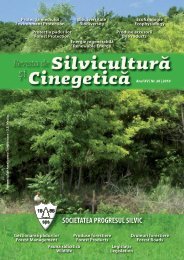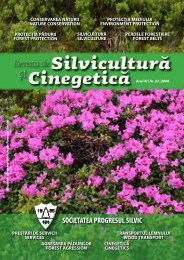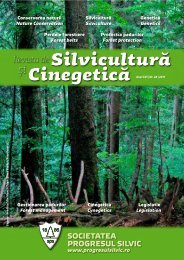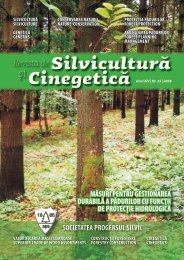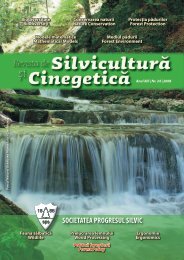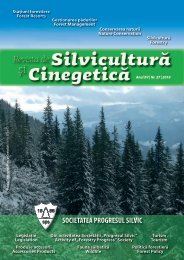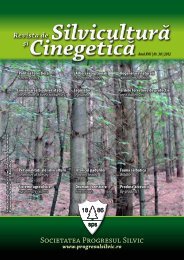Silviculture and Cinegetics Review - Societatea Progresul Silvic
Silviculture and Cinegetics Review - Societatea Progresul Silvic
Silviculture and Cinegetics Review - Societatea Progresul Silvic
Create successful ePaper yourself
Turn your PDF publications into a flip-book with our unique Google optimized e-Paper software.
FORESTRY BELTS SILVICULTURE AND CINEGETICS REVIEW XVII/30/2012<br />
II 1.255,5915 50.267,1768 2,50<br />
III 244,3954 9.827,3362 2,49<br />
The area covered by the network, its percentage <strong>and</strong><br />
the total protected area within the arable l<strong>and</strong> use<br />
category, on the three solution types, is the following<br />
(Table 4):<br />
Table 4. Arable l<strong>and</strong> – area covered by the network of forest shelterbelts, on solution types<br />
Solution type Network area - ha Total area - ha %<br />
I 3.915,2717 156.450,0458 2,50<br />
II 9.301,5302 372.673,1402 2,50<br />
III 1.781,2027 70.986,2658 2,51<br />
Within the permanent pastures l<strong>and</strong> use category, the<br />
distribution of the area of shelterbelt network at the<br />
county level reflects a variation ranging from 800 ha<br />
(Tulcea) up to 1190 ha (Constanţa).<br />
Within the arable l<strong>and</strong> l<strong>and</strong> use category the<br />
distribution of the area of forest shelterbelt network at<br />
the county level reflects a variation ranging from<br />
under 4600 ha (Tulcea) up to above 10400 ha<br />
(Constanţa).<br />
From the distribution of the forest shelterbelt network<br />
by counties, localities <strong>and</strong> l<strong>and</strong> use categories, in the<br />
Danube Plain <strong>and</strong> Dobrogea, it can be noticed the fact<br />
that in the Danube Plain, in case of arable l<strong>and</strong> use<br />
category, the localities with the largest network areas<br />
are Perişoru (443 ha) <strong>and</strong> Dragalina (398 ha) in<br />
Călăraşi county. In Dobrogea, within the same l<strong>and</strong><br />
use category, the localities with the largest network<br />
area are Casimcea (357 ha) in Tulcea county, <strong>and</strong><br />
Cobadin (322 ha) in Constanţa county.<br />
In case of pasture l<strong>and</strong> use category, in the Danube<br />
Plain, the localities with the largest network area are<br />
Smârdan (65 ha) in Galaţi county, <strong>and</strong> Ianca (26 ha) in<br />
Brăila county. In Dobrogea, within the same l<strong>and</strong> use<br />
category the localities having the largest network area<br />
are Lipniţa (84 ha) in Constanţa county, <strong>and</strong> Cerna (76<br />
ha) in Tulcea county.<br />
3.3. Establishing the necessary seedling stock for<br />
setting up the forest shelterbelts in order to adjust<br />
the production capacity of the afforestation stock<br />
<strong>and</strong> its phasing<br />
Given data obtained relating to the areas covered with<br />
forest shelterbelts up to detail level, as well as the data<br />
regarding the shelterbelts characteristics (composition,<br />
schemas <strong>and</strong> densities) were used to assess the<br />
necessary afforestation stock on solution types,<br />
totalized <strong>and</strong> differentiated by species, both at a local<br />
level <strong>and</strong> at county ones, presented in a table form.<br />
Danube Plain<br />
In the Danube Plain resulted a total number of<br />
351128600 seedlings required to establish the network<br />
of forest shelterbelts, of which the basic species<br />
(greyish oak) represents almost 40%. The<br />
differentiation of this total required of seedlings by the<br />
two l<strong>and</strong> use categories is as follows: arable l<strong>and</strong> –<br />
336828468 seedlings (of which the basic species<br />
represents approximately 40%); permanent pastures –<br />
14300131 seedlings (of which the main species<br />
represents approximately 40%).<br />
The total number of seedlings necessary for setting up<br />
the network of shelterbelts within the permanent<br />
pasture l<strong>and</strong> use, on the five solution types, is the<br />
following (Table 5):<br />
Table 5. Permanent pastures – required quantity of seedlings to set up the network of forest shelterbelts on solution<br />
types<br />
Solution type Total seedlings Basic species (Quercus sp.)<br />
IV 535.5741 2.142.296<br />
V 321.5572 1.286.229<br />
VI 668.741 267.496<br />
VII 4.468.327 1.787.331<br />
VIII 591.751 236.700<br />
The total number of seedlings required to establish the<br />
network of shelterbelts within the arable l<strong>and</strong> use<br />
category, by the five solution types, is the following<br />
(Table 6):<br />
57



